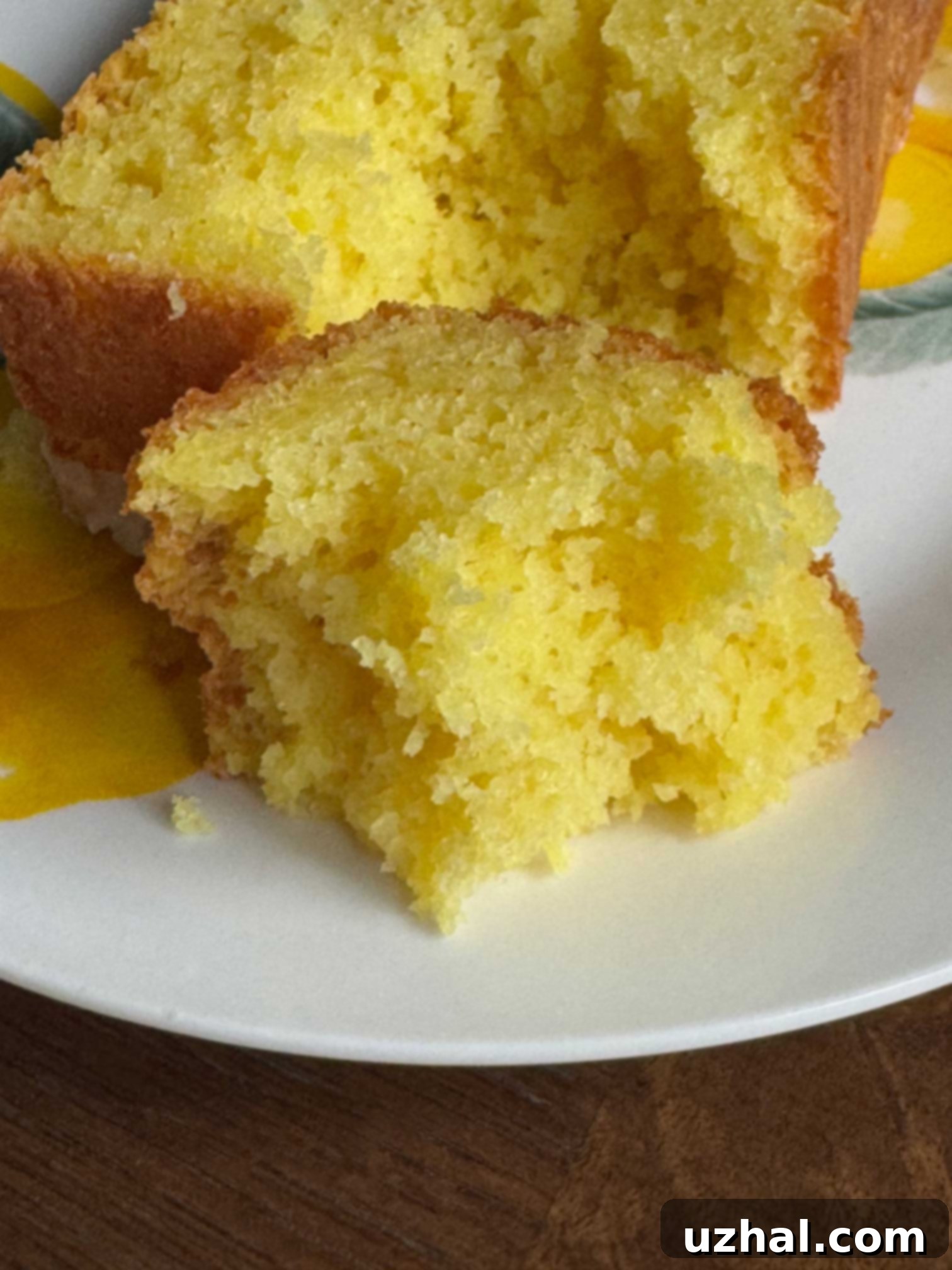The Ultimate Cake Mix Starbucks Lemon Loaf Copycat: Easy, Zesty, and Perfectly Moist
For many of us, certain flavors are inextricably linked to cherished memories. For me, the aroma and taste of a perfect lemon cake instantly transport me back to my great-grandmother’s kitchen. Her legendary Duncan Hines lemon cake wasn’t just a dessert; it was a cornerstone of family gatherings, setting an impossibly high standard for every lemon cake that followed. While that sentimental favorite will forever hold the top spot, my culinary adventures have led me to explore numerous lemon cake variations, each offering its unique charm.
One particular quest led me to the widely discussed Starbucks Copycat Lemon Loaf, a recipe prominently featured by Better Homes and Gardens. Despite its potential, the recipe initially garnered a mere two-star rating – a rather disheartening score for any dessert, especially one aiming to replicate a beloved coffee shop classic. Intrigued and determined, I embarked on baking it myself, quickly uncovering the nuances and minor adjustments required to elevate it from a humble two-star contender to a truly exceptional treat.

Why Cake Mix is Your Secret Weapon for this Easy Lemon Loaf
Let’s be honest: life gets busy. Sometimes, the thought of meticulously measuring and sifting ingredients for a complex baking project can be daunting. This is where the beauty of a cake mix truly shines, transforming what could be an intricate recipe into an incredibly simple and accessible baking experience. Whether you’re a novice baker, short on time, or even recovering from a kitchen mishap (like an accidental encounter with boiling water – trust me, it happens!), this cake mix lemon loaf recipe is your go-to for effortless deliciousness.
Don’t let the “cake mix” label fool you into thinking this is a compromise on flavor or texture. When augmented with a few key additions, a quality lemon cake mix provides a fantastic foundation, ensuring consistent results every time. It eliminates the need for separate flour, sugar, leavening agents, and salt, streamlining your baking process and minimizing cleanup. This makes it an ideal recipe for anyone craving homemade goodness without the fuss.
To embark on this delightful baking journey, you’ll need to gather a select group of ingredients. Beyond the star – a box of lemon cake mix (I highly recommend a reliable brand like Duncan Hines Signature Lemon Supreme) – you’ll also need cook & serve lemon pudding mix, large eggs, rich full-fat sour cream, neutral vegetable oil, whole milk, freshly squeezed lemon juice, and powdered sugar for that essential tangy glaze. While gathering these items is part of the process, once you have them assembled, the real fun – the baking – can begin!
Navigating Loaf Pan Sizes for the Perfect Bake
One of the most crucial, yet often overlooked, aspects of baking a perfect loaf cake is selecting the correct pan size. My experience with the Better Homes and Gardens recipe highlighted a common issue: inadequate guidance on batter volume versus pan capacity. The original recipe specifies one 9×5 inch loaf pan, but in practice, this proved to be insufficient. The sheer volume of batter, particularly when using a cake mix combined with pudding and other moist ingredients, far exceeded the capacity of a single standard 9×5 inch pan.
Upon pouring the batter into my 9×5 inch pan, it quickly became apparent that it was nearly overflowing. To salvage the situation and prevent a sticky oven mess, I carefully spooned out approximately 170 grams of batter into a mini loaf pan (which has a 2-cup capacity). In hindsight, I likely should have removed another 170 grams, as the larger loaf still ended up being quite full. The result was illustrative: the large loaf, despite tasting delicious, baked with a distinctly flat top, while the smaller, less-filled mini loaf emerged with a beautifully rounded, classic dome.
This experience taught a valuable lesson, especially pertinent for cake mix-based loaf cakes: always leave sufficient room for the batter to rise. For a characteristic rounded top, aim to fill your loaf pans no more than two-thirds full, or ideally, just a little over halfway. A standard 9×5 inch loaf pan, typically holding about 8 cups, will likely be overwhelmed by this recipe’s generous batter. For best results, I strongly recommend using two 8 ½ by 4 ½ inch loaf pans (which hold about 6 cups each) or distributing the batter among several mini loaf pans. This strategic pan choice not only ensures proper rising but also contributes to an even bake and a visually appealing finished product.

Unveiling the Perfect Cake Texture and Zesty Flavor
The texture of this cake mix lemon loaf is a delightful journey in itself. Initially, as it emerges from the oven, it possesses a lightness that might lead one to believe it won’t achieve that coveted “coffee shop pound cake” density. However, patience is key. As the loaf cools and settles, its structure transforms. It gradually becomes heavier, gaining a satisfying moistness and a wonderfully soft, tender crumb that is characteristic of premium bakery items.
For those aiming to truly replicate the Starbucks experience, allowing the cake to sit under a cake dome for several hours, or even overnight, works wonders. This resting period allows the flavors to meld and the moisture to redistribute, resulting in an even richer and more profound texture, drawing it closer to the dense yet yielding quality of a classic pound cake. This subtle transformation elevates the cake from merely good to truly outstanding.
Regarding flavor, the cake is undeniably good, delivering a pleasant lemon essence. However, for a true lemon enthusiast like myself, there was room for improvement – a desire for a more pronounced, vibrant lemon punch. While the lemon cake mix and pudding mix provide a foundational citrus note, the addition of fresh lemon zest is a game-changer. Lemon zest, containing concentrated citrus oils, imparts a brighter, more aromatic lemon flavor without adding excessive acidity or altering the cake’s delicate moisture balance. I’ve incorporated this crucial enhancement into the revised recipe, ensuring that every bite delivers an irresistible burst of zesty goodness. Don’t skip the zest if you truly love lemon!

Crafting the Irresistible Lemon Glaze That Hardens
No lemon loaf is truly complete without a luscious, tangy glaze. It’s more than just a topping; it’s an integral component that contributes additional moisture, sweetness, and, most importantly, a vital boost of lemon flavor that ties the entire dessert together. The original recipe called for 2 ½ cups of powdered sugar combined with just 3 tablespoons of lemon juice. While functional, I found this ratio yielded a glaze that was either too thick or required too much liquid to thin, potentially diluting the lemon impact. My preferred version uses 2 cups of powdered sugar but allows for a more generous amount of fresh lemon juice, typically ranging from 3 to 6 tablespoons, adjusted to achieve the perfect consistency.
One technique I employed, which deviates from my usual cold-mixing method, was to gently warm the powdered sugar and lemon juice together in a small saucepan. This simple step is surprisingly effective. Heating the mixture on low heat, while stirring constantly, helps to quickly dissolve any lingering sugar lumps, resulting in an incredibly smooth and glossy glaze. Furthermore, warming allows you to achieve a pourable consistency with less liquid, meaning you can pack in more intense lemon flavor without making the glaze too runny to “crust over.” The goal is a glaze that’s thick enough to cling to the cake and set into a firm, slightly crunchy shell, reminiscent of professional bakery loaves.
Once your cake is completely cool – and this is essential to prevent the glaze from simply melting into the cake – carefully spoon the warm, velvety lemon icing over the top. Allow it to slowly cascade down the sides, creating those appealing drips. Let the glazed loaf rest for a while, ideally at room temperature, until the icing has fully set and hardened. This creates a beautiful visual appeal and adds a textural contrast that makes each bite even more satisfying. This hardening lemon glaze not only elevates the visual presentation but also seals in moisture, ensuring your cake remains fresh and delicious for longer.
Tips for Baking the Best Cake Mix Lemon Loaf
- Full-Fat Ingredients: For the richest flavor and most tender crumb, always opt for full-fat sour cream and whole milk. These contribute significantly to the cake’s moisture and density.
- Cook & Serve Pudding: Ensure you use “cook and serve” lemon pudding mix, not instant. The cook and serve variety contains starch that activates differently during baking, contributing to the unique texture and moistness of this loaf.
- Don’t Overmix: While a stand mixer or electric hand mixer is recommended for 2 minutes of beating, avoid overmixing the batter. Overmixing can develop the gluten in the flour, leading to a tougher cake. Mix just until combined and smooth.
- Oven Temperature Accuracy: An accurate oven temperature is crucial for even baking. Consider using an oven thermometer to verify your oven’s calibration.
- Toothpick Test: To check for doneness, insert a wooden toothpick into the center of the loaf. If it comes out clean or with a few moist crumbs attached, the cake is ready. If it’s wet, continue baking for a few more minutes.
- Cooling Completely: Resist the urge to glaze a warm cake. A fully cooled cake ensures the glaze sets properly and doesn’t simply melt off.
Serving and Storage Suggestions
This Easy Cake Mix Lemon Loaf is incredibly versatile and perfect for any occasion, from a casual coffee break to an elegant brunch. Serve slices with a fresh cup of coffee or tea. For an extra touch, you might garnish with a thin slice of fresh lemon or a few candied lemon peels. Its vibrant flavor and satisfying texture make it a crowd-pleaser.
To store your lemon loaf, once the glaze has fully set, you can wrap it tightly in plastic wrap or place it in an airtight container. It will stay fresh at room temperature for up to 3-4 days. For longer storage, you can freeze individual slices or the entire loaf (unglazed, or with glaze already set) for up to 2-3 months. Thaw frozen cake overnight in the refrigerator, then bring to room temperature before serving for the best experience.
- Cake Mix Lemon Cheesecake Bars
- Double Lemon Cheesecake Bars
- Lemon Muffins with Pudding Mix
- White Chocolate Chunk Lemon Pudding Cookies
- Lemon Cake Pie
Recipe

Easy Cake Mix Lemon Loaf Cake
Anna
Pin Recipe
Ingredients
- 15.25 oz package Duncan Hines Signature Lemon Supreme Cake Mix
- 1 box cook and serve lemon pudding mix (4.3 oz)
- 4 large eggs
- 1 cup full fat sour cream
- ⅓ cup fresh lemon juice
- ⅓ cup whole milk
- ⅓ cup neutral vegetable oil like sunflower
- 1-2 teaspoons lemon zest (highly recommended)
Lemon Icing that Hardens
- 2 cups powdered sugar
- 3-6 tablespoons fresh lemon juice
Instructions
-
Preheat your oven to 350°F (175°C). Prepare your loaf pans by generously greasing and flouring them. For this recipe, it’s highly recommended to use two 8 ½ by 4 ½ inch loaf pans or a combination of one 9×5 inch pan and two smaller mini (2-cup capacity) loaf pans to accommodate the batter appropriately.
-
In a large mixing bowl, combine the lemon cake mix, cook and serve pudding mix, eggs, full-fat sour cream, fresh lemon juice, whole milk, vegetable oil, and the optional (but recommended) lemon zest. Using an electric mixer, beat the mixture for 2 minutes until it is smooth and well combined. Do not overmix.
-
Carefully pour the prepared batter into your chosen loaf pans, filling them no more than two-thirds full to allow for proper rising. Place the pans in the preheated oven and bake. The baking time will vary based on the size of your pans: a single 9×5 inch pan will require approximately 60 minutes. If using two slightly smaller 8 ½ by 4 ½ inch pans, begin checking for doneness at 45 minutes. For mini loaves, expect a baking time of about 35 minutes. A wooden toothpick inserted into the center should come out clean.
-
Once baked, remove the cakes from the oven and let them cool in their pans for about 10-15 minutes before inverting them onto a wire rack to cool completely. Ensure the cakes are entirely cool before applying the icing.
-
Prepare the Icing: Place the powdered sugar in either a large mixing bowl or a medium saucepan. Add 3 tablespoons of fresh lemon juice to start. Stir vigorously until a thick mixture forms. Gradually add more lemon juice, one tablespoon at a time, until the icing reaches a pourable, yet still thick, consistency. If using a saucepan, you can mix it off the heat, then gently warm it over low heat for a very short period (just enough to slightly melt the sugar and dissolve any lumps), allowing for a smoother, easier pour without needing excessive liquid.
-
Once the cake is completely cool, spoon the freshly prepared lemon icing generously over the top, letting it naturally drip down the sides. Allow the iced cake to sit undisturbed at room temperature until the icing firms up, creating that delightful crunchy exterior. Slice and enjoy your homemade Starbucks-style lemon loaf!
